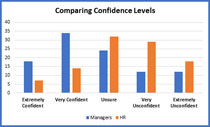Essential Steps for Handling Difficult Conversations
 As a “recovering” Human Resources professional, working in hotels no less, I’ve had my share of difficult conversations with both guests and employees. Conversations with employees ranged from body odor, to inappropriate dress, unprofessional behavior, rule infractions, personality conflicts, petty territorial disagreements, and you name it. While some workplace conversations can be difficult, avoiding them is not recommended. First, we’ll look at the consequences avoiding difficult conversations can bring and then look at the essential steps for handling them.
As a “recovering” Human Resources professional, working in hotels no less, I’ve had my share of difficult conversations with both guests and employees. Conversations with employees ranged from body odor, to inappropriate dress, unprofessional behavior, rule infractions, personality conflicts, petty territorial disagreements, and you name it. While some workplace conversations can be difficult, avoiding them is not recommended. First, we’ll look at the consequences avoiding difficult conversations can bring and then look at the essential steps for handling them.
Some people think that because an individual holds a managerial position that he or she automatically understands how to handle difficult conversations. Further, while managers may think they are confident and competent at holding difficult conversations, Human Resources (HR) holds a different opinion as indicated in the graph below.

Source: Adapted from Handling Difficult Conversations at Work
Well certainly a CEO knows how to chew these conversations up and spit them out. The fact is, that most of us don’t enjoy holding these conversations and many of us are not that skilled at having them. In fact, according to a study appearing in a Sage Publication, these conversations can be unnerving and emotionally draining. So, as human nature dictates, we avoid the unpleasant and the awkward. Failing to hold training sessions for difficult conversations is only asking for trouble.
Avoiding these conversations can lead to, in many cases, worse consequences than the reason(s) creating the need for the conversation. Here are a few examples.
- Increased stress and frustration
- The situation worsening
- Low productivity
- Lack of solutions
- Losing self-respect
- Others losing respect for you
- Loss of leadership credential with upper management
There are essential steps to help better handle difficult conversations.
- Recognize and Address: Recognize and address issues early. If you are unable to recognize poor performance, it might be time to look at other positions that do not include leadership. When you do recognize issues, it is best to address them at the earliest possible moment. When you ignore or allow poor performance, unprofessional behavior and the like to continue, you are giving those activities your tacit approval. In other words, while you are not directly saying you approve of a situation, by your lack of action, you are agreeing for it to continue.
- Build Your Case: Be sure you have a solid case before engaging in the conversation, do your homework. Gather whatever data you need to from as many sources as necessary. Research must end at some point, don’t engage in paralysis by analysis.
- Establish Goals: You must know the outcome you wish to have at the end of the conversation. This allows you to better plan your strategies and to stay on target. If it helps you, write out your conversation. However, avoid sounding scripted or your will be ineffective. You may even request that the individual not interrupt you. On the other hand, you must leave room for and invite the input of the other person’s side of the story.
- Provide Notice: Speaking of the other person’s side of the story. It is always a good idea to let the person know that you two will be engaging in a conversation about the topic at hand.
- Time and Place: Have the difficult conversation in a quiet place and do not allow interruptions. Have it a time convenient to you both. If you anticipate the individual could be violent, then it is best to have a third party in the room such as HR. However, it is not a good idea to arbitrarily lean on HR to have your difficult conversations for you. That is neither management or leadership.
- Objectivity: You must remain objective and open minded and practicing your active listening skills is an absolute must. Unfair treatment has no place in leadership.
- Making Friends: While it is never a good idea to bash or beret anyone, you are not in your positon to make friends. The study published by Sage suggests that when holding these conversations both parties must use respectful language indicating the value of one another’s roles and contributions. We all generally understand to avoid the accusatory “you” designation and to concentrate on the “I.” For example, I feel, I observed, I’m wondering if…would be better language choices. This type of language usage, according to the Sage publication, suggests that “saving face” in this manner for the employee that he/she is less likely to physically or mentally check out from the organization, or to engage in retaliatory, determinantal behaviors. However, you must ensure that the employee leaves clearly understanding your expectations.
- Wrapping Up: Keep a log of the conversation. Future conversations on the same topic, if needed, will require the employee’s signature and further actions. Ensure before the conversation ends that the employee understands the changes needed, the deadlines when these behavior changes are to take place, and that follow-up check in sessions will occur and you need to set a date for the next conversation before the employee leaves.
Handling difficult conversations may not be your favorite task as a leader. However, following these essential steps will help lessen the stress on you and the other party, encourage cooperation from the employee, provide documentation, ensure a clear message, and help everyone to move forward.
Thank you for reading this blog. If you would like to discuss a difficult conversation, call 404-320-7834, or email This email address is being protected from spambots. You need JavaScript enabled to view it., or visit www.performstrat.com
Graphic Credit: BogStock.com Copyright: auremar
Graphic Diff Conversation
CEO, Performance Management,, Diffcult Conversations,, Commication,, Human Resources,